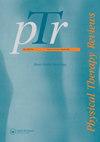探索沉浸式虚拟现实干预在肌肉骨骼疼痛管理中的有效性:最新综述
IF 0.8
Q4 REHABILITATION
引用次数: 10
摘要
摘要背景虚拟现实(VR)是一种身临其境的技术,它将用户带入一个三维的“虚拟世界”,并越来越多地被用作医疗保健各个方面的创新治疗模式。沉浸式VR在肌肉骨骼疾病管理中的应用相对较新,需要进行研究来证明其在该领域的有效性。目的本叙述性综述的目的是探索沉浸式VR干预在肌肉骨骼疾病管理中的有效性。方法在Pubmed、Scopus和Medline数据库中检索文献,检索关键词为:虚拟现实和疼痛。如果任何设计的研究报告了对肌肉骨骼疼痛患者进行沉浸式VR干预后的临床结果,则纳入其中。结果确定了13项研究,研究了沉浸式VR在肌肉骨骼疾病管理中的有效性。研究对象包括患有各种肌肉骨骼疾病的人:颈部疼痛(5)、腰痛(1)、复杂区域疼痛综合征(4)、周围神经损伤(1),纤维肌痛(1)和全膝关节置换术(2)。只发现了五项随机对照试验。结果测量包括但不限于疼痛、活动范围和残疾。结论尽管目前的研究结果很有希望,并证明沉浸式VR干预可能在肌肉骨骼管理和康复中发挥有用作用,但基于现有研究的低质量,还不能提出结论性的临床建议。未来的研究应该遵循一个具有明确标准的框架,从而产生稳健和有意义的结果,指导使用沉浸式VR的临床实践。本文章由计算机程序翻译,如有差异,请以英文原文为准。
Exploring the effectiveness of immersive Virtual Reality interventions in the management of musculoskeletal pain: a state-of-the-art review
Abstract Background Virtual Reality (VR) is an immersive technology, which transports the user to a three-dimensional ‘virtual world’ and is increasingly used as an innovative treatment modality in various aspects of healthcare. The use of immersive VR in the management of musculoskeletal conditions is relatively new and research is required to demonstrate its effectiveness in this field. Aim The aim of this narrative review is to explore the effectiveness of immersive VR interventions in the management of musculoskeletal conditions. Methods A literature search was carried out on the following databases: Pubmed, Scopus and Medline using the following keywords: Virtual Reality and Pain. Studies of any design were included if they reported clinical outcomes following an immersive VR intervention for individuals with musculoskeletal pain. Results Thirteen studies which investigated the effectiveness of immersive VR in the management of musculoskeletal conditions were identified. Studies included people with various musculoskeletal conditions: neck pain (5), low back pain (1), complex regional pain syndrome (4), peripheral nerve injury (1), fibromyalgia (1) and total knee replacement (2). Only five randomized controlled trials were found. Outcome measures included but were not limited to pain, range of motion and disability. Conclusion Although the current findings are promising and demonstrate that immersive VR interventions may have a useful role in musculoskeletal management and rehabilitation, no conclusive clinical recommendations can be made based on the low quality of available research. Future research should follow a framework with clear standards leading to robust and meaningful outcomes that will guide clinical practice using immersive VR.
求助全文
通过发布文献求助,成功后即可免费获取论文全文。
去求助
来源期刊

Physical Therapy Reviews
REHABILITATION-
CiteScore
1.30
自引率
0.00%
发文量
26
期刊介绍:
Physical Therapy Reviews is an international journal which aims to publish contemporary reviews, discussion papers and editorials within physical therapy, and in those basic and clinical sciences which are the basis of physical therapy. The journal is aimed at all those involved in research, teaching and practice within the area of physical therapy. Reviews (both descriptive and systematic) are invited in the following areas, which reflect the breadth and diversity of practice within physical therapy: •neurological rehabilitation •movement and exercise •orthopaedics and rheumatology •manual therapy and massage •sports medicine •measurement •chest physiotherapy •electrotherapeutics •obstetrics and gynaecology •complementary therapies •professional issues •musculoskeletal rehabilitation
 求助内容:
求助内容: 应助结果提醒方式:
应助结果提醒方式:


